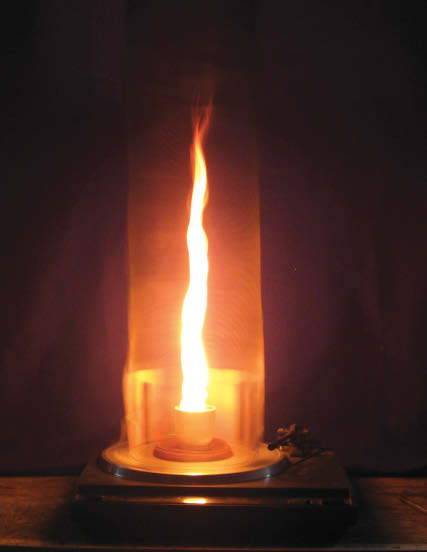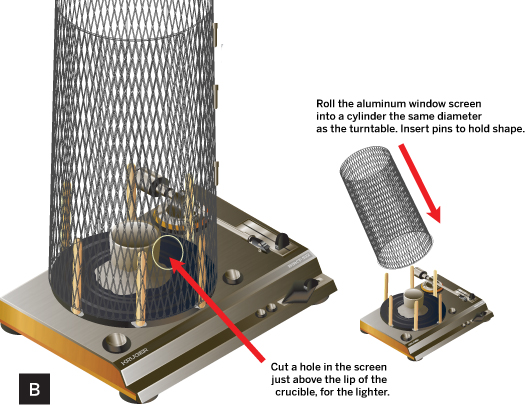![]() TIME: 1–2 HOURS
TIME: 1–2 HOURS ![]() COST: $20–$40
COST: $20–$40
The Fire Tornado
Recreate a terrifying force of nature.

Fire whirls often happen during wildland fires. They’re usually small, but under the right conditions, big ones form. Huge whirls have been recorded climbing to heights over 3,000 feet, with wind speeds exceeding 155mph — equivalent to an F3 tornado.
Meteorologists call any such phenomenon a vortex, which is just a volume of rotating fluid. Examples include smoke rings, water going down a drain, and dust devils.
In fact, fire whirls and dust devils are very similar. Both form when a layer of cool air passes over a layer of lighter hot air, which pokes a hole in the cool layer and rises through the opening. If conditions are right, the rising air begins to spin and a whirlwind forms. The rotational trigger can be as simple as a gust of wind.
The difference between dust devils and fire whirls is mostly a matter of degrees — temperature, that is. Where the dry earth under a dust devil can be as hot as 150°F, air temperatures in a fire whirl can exceed 2,000°F.
These extreme temperatures create huge columns of rising hot gas that shoot up erratically through cooler layers. Some small triggering event sets the column spinning, and a fire whirl is born. The hot gases spin like a hurricane, with greater wind speeds closer to the center, or eye. The suction pulls in extra oxygen, intensifying the flames.
Build the Fire Tornado
The Fire Tornado dramatically illustrates the effect air has on a fire’s shape, burn rate, and fuel consumption. It’s easy to build.
1. Use modeling clay to create a base for the crucible in the center of the turntable, so it stays put while spinning.
2. Epoxy or hot-glue the craft sticks to the lip of the turntable (Figure A) and let dry. (I glued mine to a raised edge midway across the platter, with a diameter of about 8½".)
3. Roll the aluminum window screen into a 36"-high cylinder of the same diameter, and cut as needed to overlap the edges by 1". Secure the seam with straight pins or wires through the mesh.
4. Carefully place the cylinder over the sticks so they hold it vertically in place. Cut a small access flap in the screen right above the lip of the crucible (Figure B). If the screen wobbles too much when it spins, try securing it to the sticks with pairs of super magnets.
William Gurstelle (facing), James Burke (A and B)
Use the Fire Tornado
Working outside, with a fire extinguisher within reach:
1. Drip 2tsp kerosene onto the cotton rag.
2. Put the rag on the turntable.
3. Secure the screen over the craft sticks.
4. Put the lighter through the flap and ignite the rag. Note the flame’s size and shape.
5. Start the turntable at its highest speed. What happens to the size and shape of the flame?
Put Out the Fire
1. Stop the turntable.
2. Put on your gloves and remove the screen.
3. Invert the large bowl and cover the crucible, smothering the flame.
Fire Tornado Physics
The flame produces hot gases that rise from the center of the burning materials, displacing cooler air above, which then sinks down around the edges of the cylinder.
Because the cylinder is spinning, the centrifugal motion pushes this cooler air toward the rotating screen, making the relative air pressure at the screen higher. But if the pressure is higher at the screen, it must be lower somewhere else, namely in the hot area above the flame. The lower pressure there allows hot gases from the burning rag to rise more easily, creating the flame vortex of the fire tornado. ![]()
William Gurstelle is a contributing editor at MAKE. This article is excerpted from his book The Practical Pyromaniac (Chicago Review Press).



